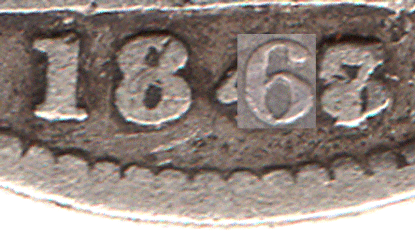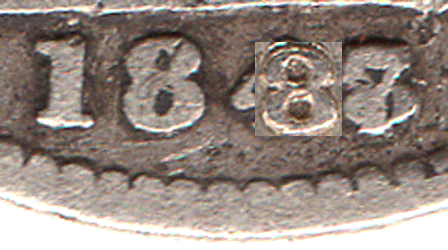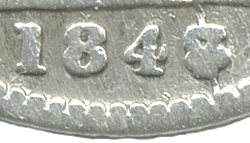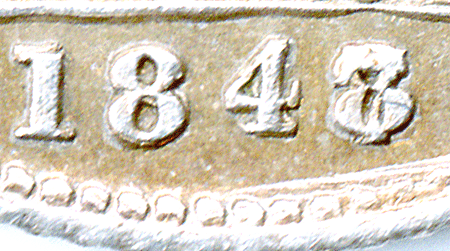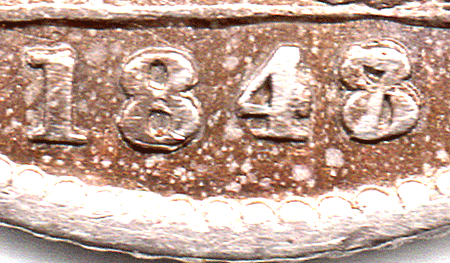|
Michael Coins Ltd |
![]() Other Lists
Other Lists
COIN CLUB
1847 Groats
All 1847 groats, so far found, have the 7 over-struck on another numeral.
No stand alone 1847 date without the 7 being over-struck have been seen.
The reference books: The English Silver Coinage from 1649 by 1st Seaby
and now published by Spink's & the British Silver Coins Since 1816 by
Peter Davies both list the 1847 Groat date variety as 7 over 6.
I feel that this is incorrect and I will show my reasoning !
Below I show the best picture I have of this extremely rare 1847 variety
together with a pictures of an 1846 Groat. Below that is a picture of the
1847 Groat with a 6 added to the left of the 7 & of the 1847 Groat with an
8 added to the left of the 7.
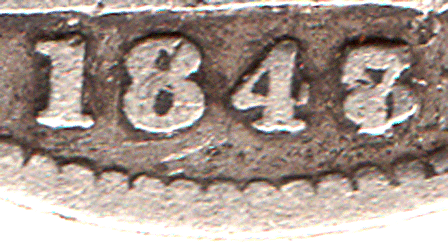 |
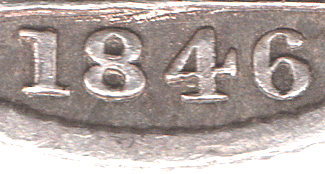 |
|
|
GR 1847 - date 7 over ? |
|
GR 1846 - date |
|
|
|
|
|
GR 1847 - with 6 added to the left of the 7 |
GR 1847 - with 8 added to the left of the 7 |
Now that one can see a 6 next to the 7 with the under-numeral one can see
that the under-numeral cannot possibly be a 6 as the lower part of the 6 is
"round" and does not match the shape of the under-numeral which is "oval" !
Also if it were a 6 the upward left back of the 6 would show which it does not.
With the next picture of an 8 next to the 7 the similarity with the under-numeral
is much closer. The 8 under the 7 is just a bit more squashed !
Let us examine the 4 in 1847 Groat.
|
|
|
|
|
GR 1847 - date 7 over 8 |
|
GR 1846 - date |
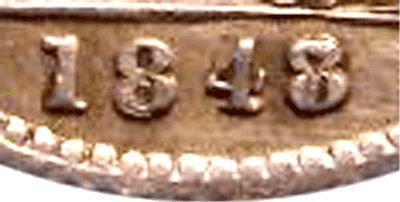 |
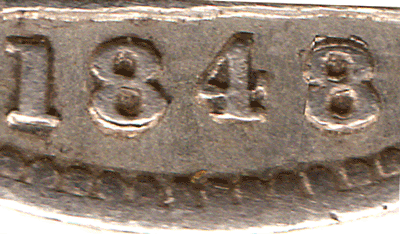 |
|
|
GR 1848 - date 8 over 7 |
|
GR 1848 - date 8 over 8 |
On examination of the 4 in the 1847 groat picture one can see that it is a small
slimmer 4, total unlike any 4 font used for the 1846 groats (which are larger).
If we examine the 4 font used in 1848 with 8 over 7 and 1848 plain date one can
see that the 4 font is virtually identical in shape, style and size !
I therefore suggest that the 7 is over an 8 and not a 6 !
I suggest that what might have happened back in 1847 & 1848 is:
Looking back at the mintage for 1846 - it was fairly large at 1,817,640 coins struck.
The mintage for 1847 was recorded at 225,720 coins it is possible that that the
entire number of Groats struck in 1847 was with 1846 (remaining) dies !
The Royal Mint was using up dies & saving money !
Dies for 1847 Groats were probably made later that year for possible use but in fact
never used ! That is the reason a plain 1847 dated Groat has never been found.
In 1848 as it is approaching the end of the 1840s it would be in the Royal Mint's
interest to use up remaining dies that still had potential use. 1848 Groats
have been found with the last 8 over 6 and the 8 over 7. That shows that there
were still life in 1846 dies as it is an easier variety to find than the 1848
8 over 7 variety.
It is normal protocol to call the last numeral of the date that is most pronounced
to be the lead coin. In the case of the 1847 groat because the 7 is higher than the
under-numeral we call this date and variety 1847 date 7 over 8.
However, I suggest that this coin was struck in 1848 and not in 1847 and that the
Royal Mint employee did NOT make a mistake of striking the 8 punch in the wrong
place - as suggested by another coin company with this comment.
This unusual over-date certainly has the 7 on top of an 8 which was likely caused by the engraver
taking an 8 punch in error first to the date and then correcting with a 7.
|
|
|
GR 1847 - date 7 over 8 (die flaw) |
This is a picture of 1847 Groat 7 over 8 with a major die flaw through the 7 over 8.
I sold this coin about 20 years ago !
It is a known fact that when any Royal Mint employee makes a repair or date
over-striking that a test strike was first made, normally at a slight angle, so as to
make sure that the letter or numeral was in the correct position. Normally when
it was accepted that the position of the test strike was correct a further heavier
strike is made to complete the repair or date over-strike.
I suggest that on this occasion the Mint employee that was doing the date
over-striking did NOT complete the action of striking the 8 punch harder over the 7
thereby leaving the 7 of the date as the most pronounced numeral.
There are far more examples of the 8 over 7 variety - where the 8 is far more
prominent that the 7 due to the heavier 2nd punch !
For 1848 8 over 7 and all the other 1848 varieties see my page on 1848 varieties.
I believe that were possibly TWO different 7 fonts used in 1847
|
|
|
GR 1847 A - Slight backward thin curved leg of the 7. The foot of the 7 rests at 6 o'clock. |
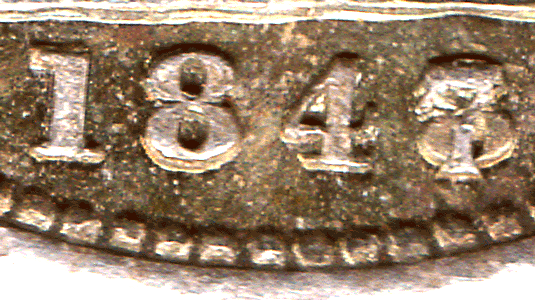 |
|
GR 1847 Aa - As per GR 1847 A - The leg of the 7 curves backwards and is thicker than GR 1847 A. The foot of the 7 also rests at 6 o'clock. |
|
|
|
GR 1847 Aa - As per GR 1847 A - The leg of the 7 curves backwards and is thicker than GR 1847 A. The foot of the 7 also rests at 6 o'clock. |
|
|
|
GR 1847 B - The leg of the 7 is angled but straight. The foot of the 7 rests at 7 o'clock |
GR 1847 A - The leg of the 7 curves slightly backwards so that the foot is a 6 o'clock.
The leg of the 7 appears to be thin and a bit stick out below the 8
GR 1847 Aa - The leg of the 7 curves slightly backwards so that the foot is a 6 o'clock.
The leg of the 7 appears to be thicker than that as seen for GR 1847 A
However, I believe that the 7 is the same font as per GR 1847 A but stronger
strike of the leg. As per GR 1847 A, a bit sticks out below the base of the 8.
GR 1847 B - The leg of the 7 is virtually straight - not curving backwards as per GR 1847 A
or GR 1847 Aa and the foot now is at 7 o'clock and NO 'bit' is below the 8.
At this stage it is difficult to know if there is any rarity difference between two 7 fonts.
| Back to Groats |
